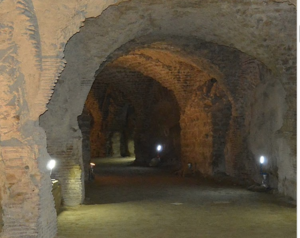Miseno facts for kids
Miseno is a small town in Italy. It's part of the larger area called Bacoli, which is in the Province of Naples. Long ago, during the time of the Romans, Miseno was known as Misenum. It was famous for having a very important Roman port.
Contents
Where is Miseno?
Miseno is located on the coast of Italy. It sits at the northwestern end of the beautiful Bay of Naples. This area is known for its stunning natural scenery.
Miseno's Ancient History
According to old stories, Miseno got its name from a character named Misenus. He was a friend of the hero Hector and played the trumpet for Aeneas. The story says Misenus drowned near here after a trumpet contest with the sea-god Triton. This tale is told in Virgil's famous poem, the Aeneid.
Because of its lovely natural setting and its closeness to important Roman cities like Puteoli and Neapolis, Miseno became a popular spot for wealthy Romans. They built fancy villas (large country homes) here. For example, the Roman general Marius had a villa here. Later, the emperor Tiberius even died in Miseno in 37 AD.
In 39 BC, an important agreement called the Pact of Misenum was signed here. It was a short-lived peace treaty between Octavian (who later became Emperor Augustus) and his rival Sextus Pompeius.
The first Roman naval base in this area was called Portus Julius. It was built nearby in 36 BC by Marcus Agrippa, a close friend of Emperor Augustus. This base was later left behind.
A new, much larger navy base was then built at Miseno. It became the most important port for the Roman fleet, known as the Classis Misenensis. This port had two natural harbors that you can still see today.
The outer harbor was protected by strong walls built into the sea. The inner harbor, called the Mare Morto (Dead Sea), was behind a strip of land. This inner harbor might have been used for ships that were not in active service or for repairs. A channel was dug to connect the two harbors.
Miseno officially became a Roman town (a municipium) in the 1st century AD.
Pliny the Elder and Vesuvius
Pliny the Elder was a Roman commander in charge of the navy fleet at Miseno in 79 AD. This was the year Mount Vesuvius erupted. Vesuvius was visible from Miseno, across the Bay of Naples.
When Pliny saw the eruption begin, he sailed closer to get a better look and to try and rescue people. Sadly, he died during the eruption. His nephew, Pliny the Younger, who was also living in Miseno at the time, wrote about his uncle's death.
Ancient Roman Buildings in Miseno
Most of the ancient Roman town of Miseno, including the navy barracks, is buried under the modern town. This makes it hard for archaeologists to study its full layout. However, they have found many important items, especially from the old burial grounds (necropolis).
Archaeologists have also focused on the fancy Roman villas along the coast. These villas often had their own fishponds and private harbors.
Grotta Dragonara
The Grotta Dragonara is a huge Roman cistern (a large tank for holding water). It was dug into the cliff right next to the harbor. It might have supplied water to the navy base or to the Villa of Lucullus, which was likely on the hill above.
Roman Theatre
There is also a Roman theatre located on the coast. It was carved into the soft rock cliffs. Part of it is now underwater because the ground has slowly sunk over time (a process called bradyseism).
Pliny's Possible Villa
Near the theatre, a large Roman villa complex was recently found. Based on its age and its perfect view of the port and the Gulf, it might have been where Pliny the Elder lived.
The Sacellum of the Augustales
The sacellum of the Augustales is another ancient building that is partly underwater due to rising groundwater.
It was discovered in 1968. This building was used by a group of priests called the Augustales. These priests were often freed slaves who were in charge of worshipping the emperor Augustus and the emperors who came after him.
The building had a courtyard with columns. In the center were three rooms, and one of them was the sacellum itself. This room had a rounded end (an apse) and an altar reached by marble steps. Statues of emperors Vespasian and his son Titus were found here. A bronze statue of Vespasian's other son, Domitian, was also found. This statue had been changed to look like his successor, Nerva, after Domitian's records were erased from history (a process called damnatio memoriae).
A reconstructed part of the sacellum, showing its four columns, is now in a museum. It was more than 7 meters (about 23 feet) tall.
Famous People Connected to Miseno
- The famous Roman speaker Cicero once made fun of Mark Antony for owning property in Miseno that he had to share because of his debts.
- The powerful Roman empress Agrippina the Younger lived in a palace here before she died.
- Emperor Tiberius also died in Miseno.
- Miseno is said to be the birthplace of Saint Sossius, a religious leader who was killed for his beliefs.
Miseno in Stories
- Miseno is one of the main places in Robert Harris' novel Pompeii. The main character, Attilius, works at the Piscina Mirabilis in Miseno. This was a huge reservoir that held water from the Aqua Augusta aqueduct.
- In the novel Ben-Hur, Miseno is where a wealthy Roman, Quintus Arrius, had a villa. He later left it to his adopted son, Judah Ben-Hur, and the Ben-Hur family lived there.
See also
 In Spanish: Miseno para niños
In Spanish: Miseno para niños






